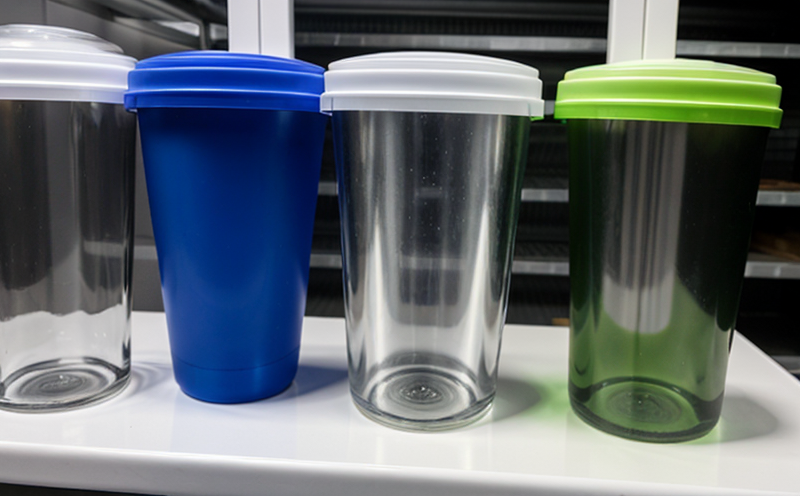ASTM D3727-08 Puncture and Impact Resistance
The ASTM D3727-08 standard test method is a critical tool for evaluating the puncture resistance and impact strength of glass packaging materials. This method helps ensure that glass containers are robust enough to withstand the stresses encountered during transportation, handling, and storage.
Understanding the importance of this test begins with recognizing how glass packaging can be subjected to various forces in real-world conditions. For instance, glass bottles may experience impacts from dropping or stacking, as well as punctures from closures or lids. ASTM D3727-08 provides a standardized approach to assess these properties.
The test involves subjecting specimens of the glass packaging material to controlled puncture and impact forces. The goal is to determine the maximum force required to penetrate the sample or the point at which it fractures under impact. This information is crucial for ensuring that the glass containers meet safety standards and perform reliably in their intended applications.
For quality managers, ASTM D3727-08 provides a clear pathway to verify that production meets stringent requirements. Compliance officers can leverage this test to ensure regulatory adherence. R&D engineers benefit from detailed data on material performance, while procurement teams can use the results to select suppliers who meet these rigorous standards.
The test is particularly relevant for industries such as food and beverage, pharmaceuticals, and cosmetics, where packaging integrity directly impacts product safety and consumer confidence. By ensuring that glass containers are puncture-resistant and impact-strength compliant, businesses can enhance their brand reputation and protect against potential legal risks associated with compromised packaging.
Why It Matters
The durability of glass packaging is not just a matter of aesthetics; it plays a critical role in safeguarding the contents. Puncture resistance and impact strength are key factors that determine whether a glass container can withstand the rigors of distribution without compromising its integrity.
Consider the consequences of inadequate puncture resistance or poor impact performance. A single compromised bottle could lead to contamination, leakage, or even breakage during transit. In the worst-case scenario, this could result in product spoilage and subsequent recalls, leading to significant financial losses and reputational damage for manufacturers.
From a consumer perspective, trust is paramount. When consumers purchase products packaged in glass containers, they expect these packages to protect their goods throughout the supply chain. A failure in puncture resistance or impact strength can undermine this trust, leading to dissatisfaction and potential loss of market share.
The ASTM D3727-08 test addresses these concerns by providing a robust framework for evaluating glass packaging materials. By adhering to this standard, manufacturers can ensure that their products are safe, reliable, and meet the highest quality standards. This not only protects consumers but also enhances brand loyalty and market competitiveness.
Scope and Methodology
| Parameter | Description |
|---|---|
| Puncture Force | The maximum force required to penetrate the glass specimen with a specified puncture tool. |
| Impact Energy | The energy imparted to the specimen during impact testing, measured in joules. |
| Specimen Preparation | Cylindrical specimens with a specified diameter and height are cut from the glass material under controlled conditions. |
| Instrumentation | The test is conducted using specialized equipment that applies puncture forces and impact energy as per the standard. |
The ASTM D3727-08 method specifies precise conditions for testing, including specimen preparation, instrumentation, and environmental controls. The goal is to ensure consistency in results across different laboratories and tests. This standardized approach allows for accurate comparison of data from various sources.
During the puncture test, a specified tool is used to apply increasing force against the glass specimen until penetration occurs. The impact test involves dropping a weighted hammer onto the specimen from a controlled height, measuring both the impact energy and the resulting damage. These tests are designed to simulate real-world conditions that glass packaging might encounter.
The acceptance criteria for this test are based on predefined limits for puncture force and impact energy. Specimens that meet these criteria are considered compliant with ASTM D3727-08, ensuring they can withstand the necessary stresses without failure.
Environmental and Sustainability Contributions
- Reduces Waste: Robust glass packaging minimizes breakage during transportation, reducing waste in landfills.
- Eco-Friendly Manufacturing: The recycling of glass containers at the end of their lifecycle contributes to a circular economy.
- Increased Efficiency: By ensuring that glass packaging is puncture-resistant and impact-strength compliant, manufacturers can reduce the need for additional packaging layers or materials.
The ASTM D3727-08 test plays a vital role in promoting sustainability by encouraging the development of high-performance glass packaging. This not only enhances environmental responsibility but also supports broader industrial goals such as reducing carbon footprints and resource consumption.
Furthermore, compliance with this standard can lead to certifications and endorsements from environmental organizations, providing businesses with an additional competitive advantage in the market. By demonstrating a commitment to sustainability through rigorous testing, companies can build stronger relationships with environmentally conscious consumers.





